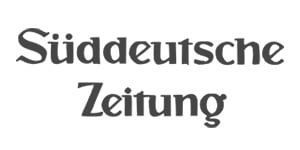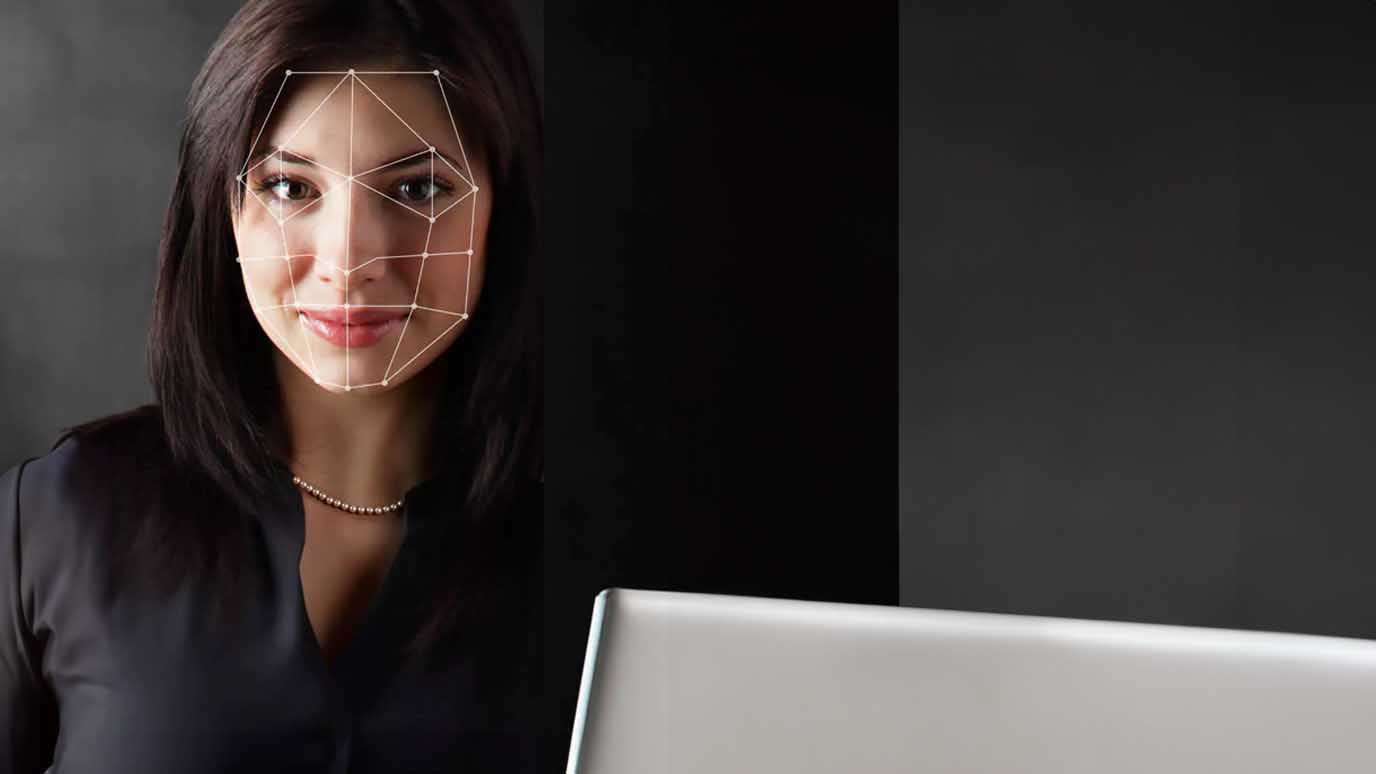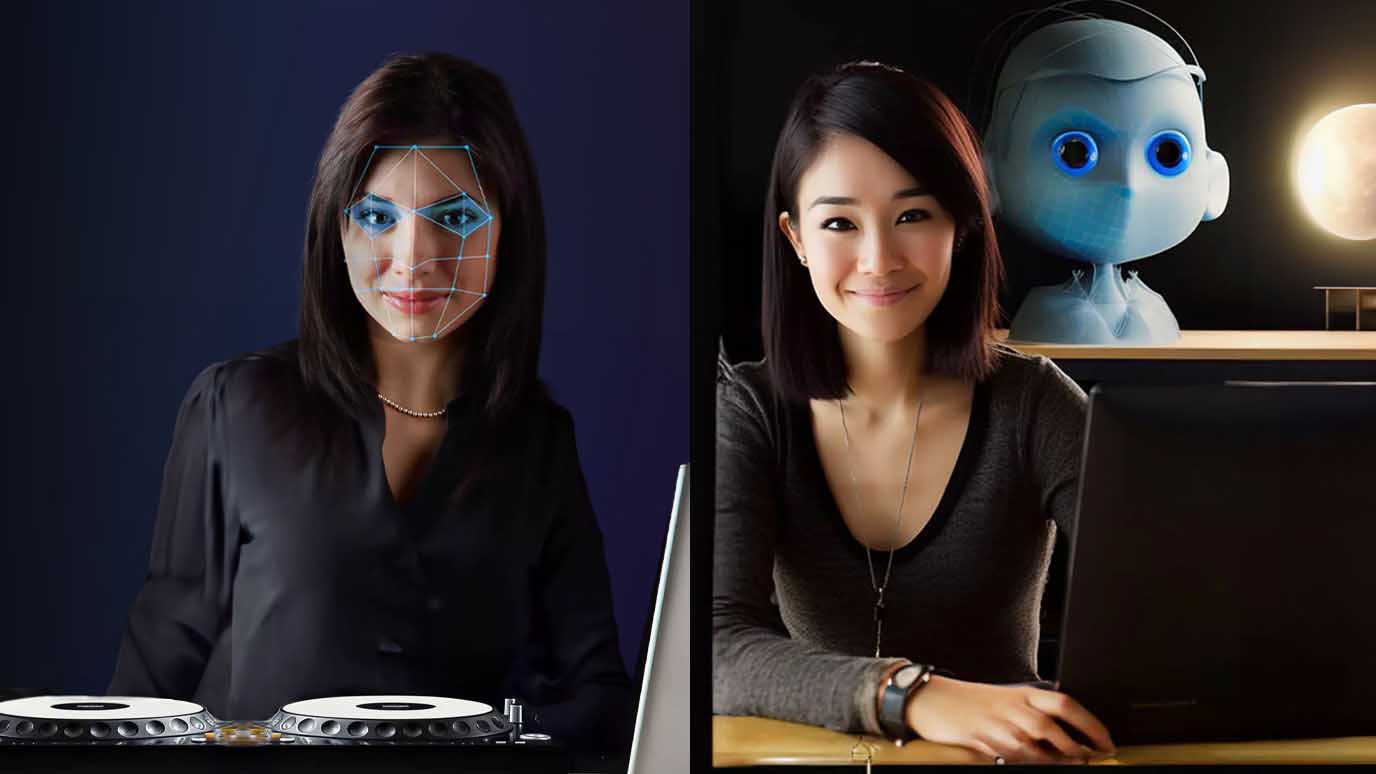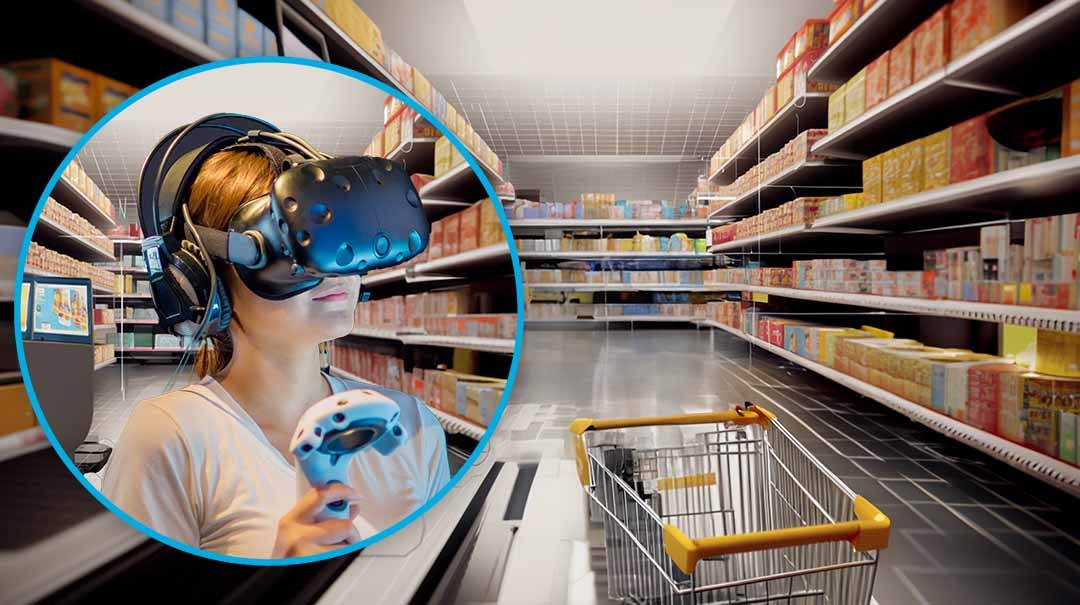Experts in AI-driven 3D facial and eye-tracking technologies.
Unlock new possibilities in user experience and security with our expertise in AI-driven 3D facial recognition and eye-tracking.
- Full-service: We support you from concept to operation. Utilize hyper-realistic avatars in VR training or automate access control in high-security industrial areas.
- Custom Solutions: Our technology is industry-independent and tailored specifically to your needs. Whether it’s customer service robots with emotion recognition or personalized virtual shopping experiences – we make it possible.
- Technological Edge: Take the lead with advanced AI-driven 3D facial and eye-tracking technologies. Optimize your advertising strategies through real-time analysis of viewer reactions or use our technology in medical diagnostics.
Leverage our multidisciplinary expertise for unique, secure, and interactive user experiences.
Visoric’s Expertise in AI-driven 3D Facial and Eye Recognition
What is AI-driven 3D Facial and Eye Recognition?
We rely on AI-driven 3D facial and eye recognition frameworks to achieve success through innovation across various sectors. Whether it’s learning software development for the Apple Vision Pro Mixed Reality Glasses, 3D AI service tools for the Magic Leap 2 AR headset, or VR training worlds for supermarket shelf design – we have the right solution. Want to achieve new goals with technical innovations? Talk to us.
Adaptability and Flexibility:
The AI-driven 3D facial and eye recognition frameworks we develop are customized to perfectly fit your industry and application area. You want to control emotion-driven avatars with user mimicry in your virtual showroom, animate characters to life through a 3D studio pipeline, or track the focus of participants in a VR marketing test app? Then talk to us.
Boundless Possibilities:
The combination of AI with 3D facial and eye recognition is revolutionizing the way we interact and do business. From personalized augmented reality interfaces to secure access solutions in the Industrial Metaverse, AI-driven 3D facial and eye recognition frameworks enable a barrier-free, secure, comfortable, and sustainable digital world, apps, and production pipelines. Want to know more? We look forward to your inquiry.
If you’re ready to reach the next level in the digital transformation of your business, contact us for customized consultation.
How Your Business Benefits from Our AI-Driven 3D Facial and Eye Recognition Innovations
Cost Efficiency through Automation: Automate processes like access control and customer interactions with our AI technology in 3D facial and eye recognition, leading to long-term cost savings.
Faster Decision Making: Real-time analyses provide immediate insights into customer behavior, enabling data-driven decisions, better resource utilization, and higher profits.
Increased Customer Loyalty: Personalized, interactive experiences boost customer satisfaction and encourage loyalty.
Risk Mitigation: In critical areas such as medicine and industry, our technology minimizes errors and increases safety, thereby reducing liability risks.
How to reach us!
Email: info@visoric.com
Phone: +49 89 21552678
Contact Person:
Ulrich Buckenlei (Creative Director)
Mobile +49 152 53532871
Email: ulrich.buckenlei@visoric.com
Nataliya Daniltseva (Project Manager)
Mobile + 49 176 72805705
Email: nataliya.daniltseva@visoric.com
Address:
VISORIC GmbH
Bayerstraße 13
D-80335 Munich

Questions about AI-Driven 3D Facial and Eye Recognition?
If you’d like to learn more about the diverse applications and advantages of our AI-driven 3D facial and eye recognition technologies, we’re here to help. Don’t hesitate to contact us! We look forward to your inquiry.
Where is AI-Driven 3D Facial Recognition used in Business?
Use of VR Training Programs with AI-Based 3D Facial and Eye Tracking
Applications:
- Personalized Experiences: Our VR training programs are designed to respond to the individual performance and attention of the user. AI technology allows for precise adaptation of the training environment to the needs of each individual.
- Real-Time Analysis and Data-Driven Decisions: The programs provide immediate feedback and enable real-time adjustments, allowing for data-driven optimization of training results.
- Future-Proof Technology: Stay up-to-date with the latest developments in AI and XR technology, which are constantly integrated into our training programs.
- Cost Savings: The automation of training processes leads to significant cost savings, as fewer manual interventions are required.
- Increased Customer Loyalty: By improving the user experience, we increase the loyalty of participants in our training programs.
Benefits:
- Enhanced Learning: Realistic simulation and individual feedback make learning more effective and sustainable.
- Scalability: The programs can be easily adapted to different group sizes and various learning needs.
- Increased Safety: Risk-free training in simulated environments reduces accident risks in real-world applications.
- Accessibility: Remote access to training modules enables global reach and flexibility.
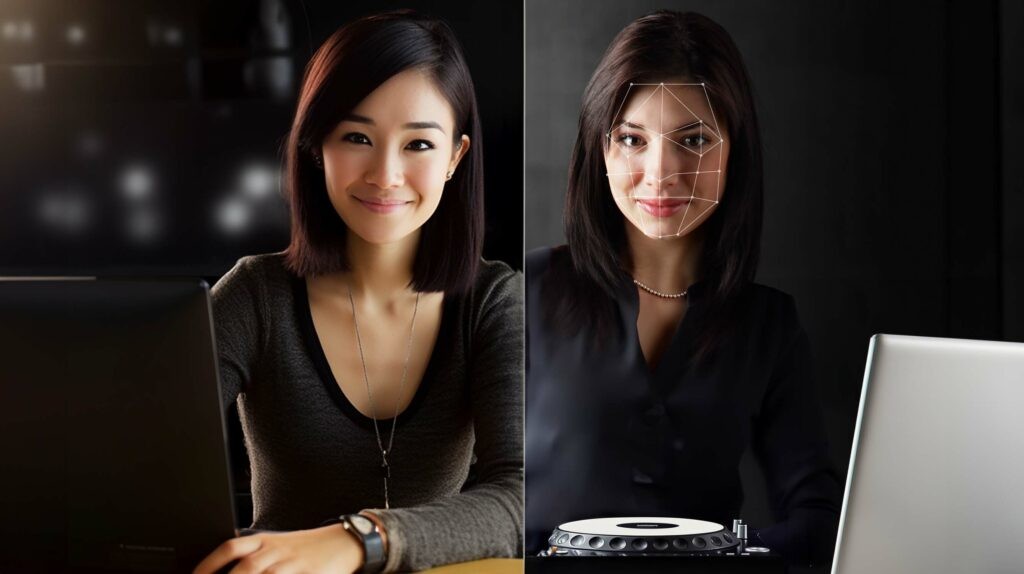
Hyperrealistic Avatars in Virtual Reality (VR) with AI-Based 3D Facial and Eye Tracking
Areas of Application:
- Personalized Experiences: Our hyperrealistic avatars can simulate human-like facial and eye movements thanks to AI, making interaction in virtual space more natural and authentic.
- Emotional Intelligence: AI technology enables our avatars to respond to the emotional states of users, leading to an improved user experience.
- Enhanced Security: Improved identification processes through AI-driven facial and eye recognition, especially in applications such as access control.
- Future-Proof Technology: Stay up-to-date with the latest in AI and VR technology, which are constantly integrated into our avatars.
- Increased Efficiency: The realistic avatars enable faster and more accurate service provision in various industries.
Benefits:
- Expanded Reality Perception: Creation of an immersive and credible virtual reality.
- Improved Customer Interaction: More personal and emotionally engaging customer relationships through realistic avatars.
- Innovative Marketing Strategies: Use of avatars for creative and appealing advertising and marketing campaigns.
- Advanced Research and Development Applications: Use in training, education, and research for realistic simulations.
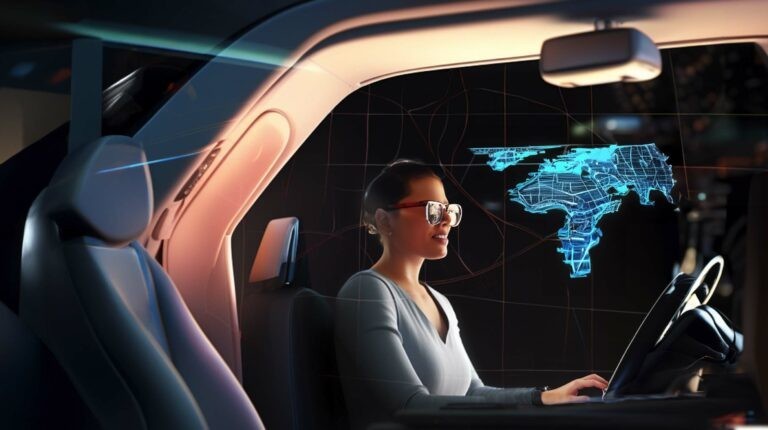
Vehicle Cockpit Optimization through AI-Driven 3D Facial and Eye Recognition
Areas of Application:
- Driver Monitoring: Real-time detection of fatigue or distraction to prevent accidents.
- User Interface Optimization: Adjustment of cockpit elements based on the driver’s line of sight and attention.
- Increased Safety: Reduction of accidents through improved driver monitoring.
- Efficiency: Faster reaction times and more intuitive user interfaces.
Benefits:
- Enhanced Driver Comfort: Individual adjustments in the cockpit improve driver comfort and user experience.
- Improved Driving Dynamics: Adaptable systems contribute to safer and more efficient driving dynamics.
- Personalized Settings: Automatic adjustment of cockpit settings to individual preferences.
- Technological Leadership: Use of cutting-edge technologies enhances brand image and competitiveness.
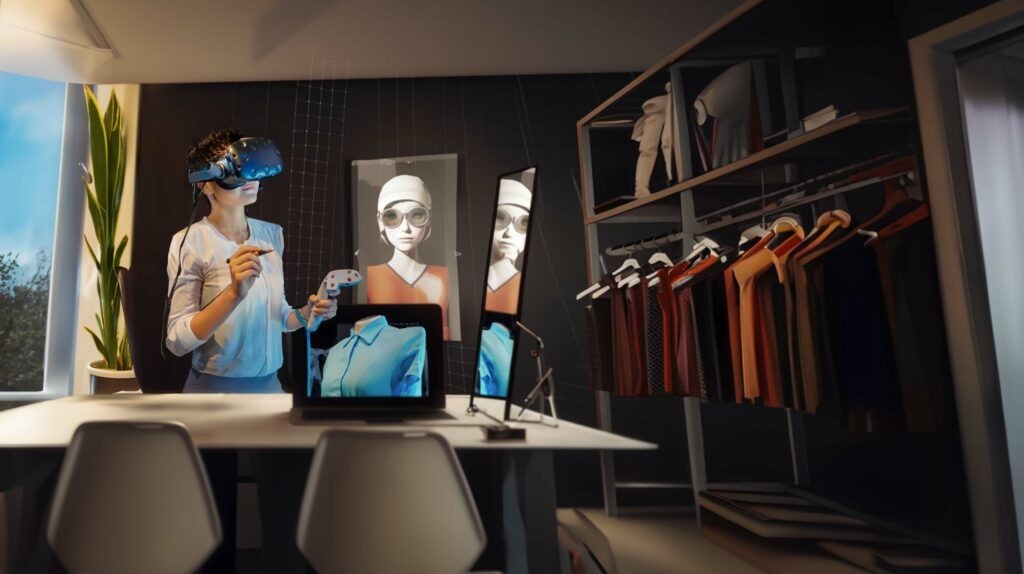
Shop Optimization through AI-Driven 3D Facial and Eye Recognition
Areas of Application:
- Product Placement: Analysis of customer behavior for optimal product placement.
- Customer Interaction: Personalization of advertising content based on gaze behavior.
- Customer Loyalty: Improving customer experience through personalized interaction.
- Revenue Increase: More efficient product placement and advertising strategies.
Benefits:
- Improved Customer Insights: Deeper insights into customer behavior enable more targeted marketing strategies.
- Increased Store Attractiveness: Innovative technologies make the shopping process more attractive and interactive.
- Optimized Inventory Management: More efficient organization and management of inventory based on customer preferences.
- Enhancement of Brand Loyalty: Improved customer experiences strengthen brand loyalty.
Potential of AI-Driven 3D Facial and Eye Recognition in Core Areas:
- Vehicle Cockpit Optimization: Provides new approaches for enhancing safety and efficiency in vehicle cockpits through AI-based facial and eye tracking.
- Shop Optimization in Digital 3D Twin: Offers unique opportunities for boosting customer satisfaction and revenue in physical and digital retail environments through targeted product placement and layout design.
- VR Training Programs: Customizable training environments that respond to individual user performance and attention.
- Hyperrealistic Avatars in VR: Creation of avatars with human-like facial and eye movements.
Additional Benefits:
- Enhanced Safety: Allows for precise identification and monitoring.
- Efficiency and Customer Retention: Improves customer satisfaction and loyalty through personalized experiences.
Explore selected examples of our AI-driven 3D facial and eye recognition
For over 14 years, our fascination and enthusiasm have been dedicated to developing high-performance, exceptionally realistic AI-supported 3D facial and eye recognition. We are excited to enter new levels of interactive and immersive user experience with you. Let’s create something extraordinary together.
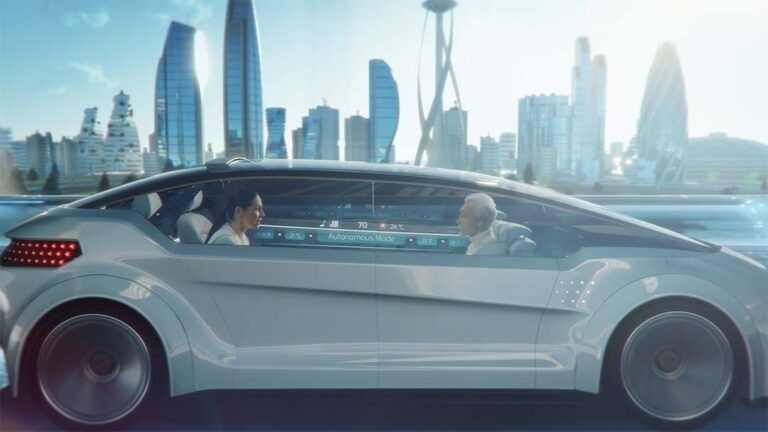
3D Facial Recognition Best Practices
3D Facial Recognition and Visoric Vehicle AR-Cockpit Usability Studies
This advanced model demonstrates the use of 3D facial recognition and eye-tracking technology in the automotive industry and beyond.
Implementation and Management:
The 3D facial recognition technology can seamlessly integrate into existing AR-Cockpit solutions. By combining virtual reality studies with the cloud-based XR Stager authoring system, realistic user experiences are created. These can be centrally managed and presented across a variety of platforms.
Versatile Display through the XR Stager Viewer:
The digital twin of the augmented cockpit can not only be experienced in a VR headset but can also be displayed on a wide range of virtual and mixed reality glasses as well as other devices like smartphones and tablets via the XR Stager Cloud. This allows for diverse use-cases, presentation, and collaboration scenarios.
Successes:
The integration of 3D facial recognition and eye-tracking into the cockpit of the digital vehicle twin has improved both the safety and quality of the cockpit experience. By combining with the XR Stager, companies can review development and design outcomes and adapt to changing conditions. This allows the digital twin to be seamlessly transferred to the real vehicle, resulting in significant cost and time savings.
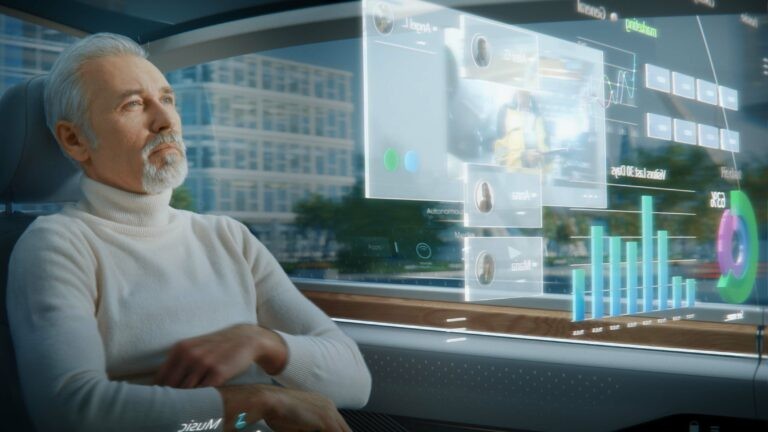
3D Facial Recognition Best Practices
AI and Facial Recognition in Office Communication
Visoric’s latest development is a 3D Avatar Office Assistant that integrates facial recognition features. While this technology has the potential to improve office communication and security, it remains a subject of ongoing research and evaluation.
Implementation:
The technology is based on Visoric’s XR Stager Cloud Solution Platform and utilizes machine learning for facial recognition. The system is modular and capable of interacting with existing Enterprise Resource Planning systems (ERP).
Device Compatibility:
The 3D Avatar Office Assistant is accessible across a range of devices, including traditional computers, tablets, and mixed-reality headsets. The efficiency and security of the facial recognition are dependent on the quality of the hardware used and are therefore variable.
Preliminary Results:
Initial case studies with the implementation of the 3D Avatar Office Assistant have shown a moderate increase in efficiency for routine-based tasks. However, it should be noted that further investigations are needed, especially in terms of the ethical implications of facial recognition and the long-term effects on employee productivity and satisfaction.
3D Facial Recognition Best Practices
Data Capture and Analysis for Shop Optimization through AI-Driven 3D Facial and Eye Recognition
The use of AI-driven 3D facial and eye recognition systems for shop optimization is an emerging field of research with high potential, but also with ethical and data protection challenges. Visoric is currently conducting pilot studies to assess the effectiveness of these technologies.
Implementation:
Visoric’s data capture and analysis solution utilizes advanced AI algorithms for facial and eye recognition. These systems are designed to analyze shopping patterns and behaviors in real-time. The data is then used to optimize shop layouts and personalize marketing strategies.
Hardware and Software:
The systems are available both as standalone hardware solutions and as software plug-ins that can be integrated into existing point-of-sale systems and security infrastructures. The effectiveness of the technology depends on a variety of factors, including the quality of the cameras used and the computing power of the servers deployed.
Preliminary Results and Challenges:
Initial studies show an improvement in capturing customer movements and interactions in the store, which could potentially lead to higher conversion rates. However, there are significant concerns regarding the ethical and data protection aspects of this technology, particularly in terms of collecting biometric data without the explicit consent of those concerned.
How to GO NEXT.
We are your reliable partner for AI-driven 3D Facial and Eye Recognition solutions for businesses.
- Consultation: We assess your company’s needs in the realm of AI-driven facial and eye recognition and offer comprehensive consultation.
- Implementation: We develop tailor-made AI-driven 3D facial and eye recognition solutions that are aligned with your company’s goals.
- Support: We provide ongoing support and updates to ensure your AI systems remain efficient and up-to-date.
Harness the potential of AI-driven 3D facial and eye recognition to fully capitalize on your company’s capabilities.
What you can expect from the AI-driven 3D Facial and Eye Recognition Demo:
Concrete Examples: Experience how AI-driven 3D facial and eye recognition can transform your business through realistic use-cases.
Interactive Experience: Learn more about the benefits of AI-driven facial and eye recognition and how this technology can be integrated into your business.
Personalized Consultation: Our experts are available to discuss your specific requirements in the context of AI-driven 3D facial and eye recognition and offer customized solutions.
FAQ on 3D Face Recoginition
How does 3D face recognition work with AI technology?
3D face recognition with AI technology enables the identification and measurement of faces in real-time. This is accomplished by using special cameras like depth cameras and algorithms based on machine learning. Other technologies, such as structured lighting, can also be used to capture the nuances of the face.
Visoric GmbH specializes in the development of 3D face recognition applications with integrated AI, offering custom solutions for businesses and industries. These applications allow companies to recognize and evaluate the faces and identities of their customers to create personalized offers and enhance user experience.
If you would like to learn more about the capabilities of 3D face recognition and AI technology, do not hesitate to contact Visoric GmbH. They will be happy to assist you and work together to develop a solution that is perfectly tailored to your needs and requirements. By using advanced AI technology and experienced specialists, Visoric GmbH can help you improve your business processes and outcomes, giving you a competitive advantage.
What are the advantages of using 3D facial recognition with AI technology in virtual testing environments?
The use of 3D facial recognition with AI technology in virtual testing environments offers a range of advantages, including:
Controlled Environment: In virtual testing environments, companies can simulate customer interactions and behavioral patterns in a secure and controlled setting rather than testing in a real-world environment.
Data Analysis: The use of AI algorithms to evaluate data in virtual testing environments allows companies to obtain extensive data about customer interactions and behavioral patterns, enabling them to enhance their services and offerings.
Time and Cost Efficiency: Utilizing virtual testing environments allows companies to conduct tests more quickly and cost-effectively, as they do not have to incur the costs of performing tests in real-world environments.
Flexibility: Virtual testing environments enable companies to simulate various scenarios and environments to determine optimal product placement, shelf design, and in-store navigation.
Realism: The use of 3D facial recognition and AI technology in virtual testing environments allows companies to create more realistic and credible simulations, enabling them to gain more accurate insights into customer behavior and make test results more reliable.
Personalization: The use of 3D facial recognition enables the simulation and analysis of individual customer behavior and interactions, allowing the development of personalized offers and solutions tailored to the customer’s specific needs.
Resource Savings: No physical resources such as products, shelves, and other facilities need to be utilized in virtual environments, leading to cost savings.
Overall, utilizing 3D facial recognition with AI technology in virtual testing environments provides companies the opportunity to optimize their services and offerings in real stores by creating more realistic simulations and obtaining extensive data about customer behavior.
Where is AI-driven 3D face and eye recognition used in companies?
- Use of VR Training Programs with AI-Based 3D Face and Eye Tracking:
- Personalized Experiences: Our VR training programs are designed to respond to each user's individual performance and attention.
- Real-Time Analysis and Data-Driven Decisions: The programs provide instant feedback and allow real-time adjustments.
- Hyperrealistic Avatars in Virtual Reality (VR) with AI-Based 3D Face and Eye Tracking:
- Personalized Experiences: Our hyperrealistic avatars can simulate human-like facial and eye movements thanks to AI.
- Emotional Intelligence: AI technology allows our avatars to respond to users' emotional states.
- Vehicle Cockpit Optimization Through AI-Driven 3D Face and Eye Recognition:
- Driver Monitoring: Real-time detection of fatigue or distraction to avoid accidents.
- User Interface Optimization: Adjusting cockpit elements based on the driver’s direction of gaze and attention.
- Shop Optimization Through AI-Driven 3D Face and Eye Recognition:
- Product Placement: Analyzing customer behavior for optimal product placement.
- Customer Interaction: Personalization of advertising content based on viewing behavior.
Visoric Expert Team for 3D Face and Eye Recognition with AI: The Visoric expert team is ready to assist and advise you on 3D face and eye recognition with Artificial Intelligence. Benefit from our extensive expertise and experience in this innovative field and discover how you can optimally use these technologies for your company.
How can eye tracking be used in marketing?
Eye tracking can be used in marketing in various ways to better understand consumer behavior and preferences. Here are some ways in which eye tracking can be applied in marketing:
- Ad Optimization: Eye tracking allows for the optimization of ads and promotional materials by analyzing which parts of the ad capture the viewers' attention the most. Marketers can use these insights to improve the placement of key messages or visual elements.
- Website Analysis: On websites, eye tracking can be used to understand how users navigate through the pages. This can help optimize website design and content to enhance user experience and increase conversions.
- Product Placement: When developing products or packaging, eye tracking can assist in determining the best placement of brand logos or product features to maximize visibility and appeal.
- Packaging Design: For consumer goods companies, packaging design is critical. Eye tracking can be used to identify which parts of the packaging are noticed first and which colors or graphics are most appealing.
- Content Marketing: When creating content, whether in the form of articles, videos, or interactive elements, eye tracking can reveal which parts of the content receive the most attention. This can help tailor content more effectively and highlight relevant information.
- Retail Layouts: In retail, eye tracking can be employed to optimize store layouts. It helps determine how customers move through the store, which shelves or products are most appealing, and how long they linger in different sections.
- Advertising Success Analysis: After a advertising campaign has run, eye tracking can be used to analyze its success. Marketers can assess whether the ads are capturing the desired attention and if viewers are taking the intended actions.
- Mobile Apps: In mobile apps, eye tracking can contribute to improving the user interface and user experience. It can also be used to optimize ad placements within apps.
- Online Videos: For video content, whether on YouTube, streaming platforms, or corporate websites, eye tracking can reveal which parts of the videos are watched the most. This can assist in video optimization and production.
- Social Media: In social media, marketers can analyze where users' gaze goes in images or videos. This can be valuable in creating engaging content for social platforms.
Eye tracking in marketing provides deep insights into consumer behavior and preferences. These insights can help refine marketing strategies, better target audiences, and enhance the effectiveness of advertising efforts.
What does Visoric GmbH offer in the field of 3D facial recognition and eye tracking?
Visoric GmbH provides expertise in AI-driven 3D facial recognition and eye-tracking technologies, offering the following:
- Trusted Partnerships: Visoric has a track record of trusted partnerships in the field of 3D facial recognition and eye tracking.
- Complete Service: They offer end-to-end support, from conceptualization to implementation. This includes using hyper-realistic avatars in VR training or automating access control in highly secure industrial environments.
- Custom Solutions: Visoric's technology is adaptable across various industries and can be tailored to specific needs. This includes applications like customer service robots with emotion recognition or personalized virtual shopping experiences.
- Technological Advancement: They leverage advanced AI-driven 3D facial recognition and eye-tracking technologies to stay at the forefront. This can be used for real-time viewer reaction analysis in advertising or in medical diagnostics.
- Multidisciplinary Expertise: Visoric offers multidisciplinary expertise to create unique, secure, and interactive user experiences.
Visoric specializes in AI-driven 3D facial and eye recognition technologies that can be adapted to various fields, from mixed reality to VR training. Their solutions are highly customizable and offer a wide range of possibilities, from emotional avatars for virtual showrooms to real-time tracking of participant focus in VR marketing apps. These technologies are designed to enhance user experiences and drive innovation.
Visoric's AI-driven 3D facial recognition and eye tracking solutions are adaptable, flexible, and offer limitless possibilities for interaction and business processes. Whether you're looking to create personalized AR interfaces or secure access solutions in the Industrial Metaverse, Visoric's expertise can help you achieve your digital transformation goals.
What are the advantages of collaborating with Visoric GmbH?
Visoric GmbH is a leading company in the field of digital technology, offering top-notch services, cutting-edge technologies, and an experienced team of specialists. They provide innovative testing environments and insights into data that are highly beneficial for businesses.
Can 3D face recognition and eye tracking be used in a real environment?
Yes, both 3D face recognition and eye tracking can be used in real-world environments. These technologies have a wide range of applications that extend beyond controlled laboratory settings. Here are some examples of how they can be applied in real-world scenarios:
3D Face Recognition in Real Environments:
- Security and Access Control: 3D face recognition can be employed for access control and security purposes in various real-world locations such as airports, office buildings, and secure facilities.
- Payment Authentication: Some mobile devices and payment systems use 3D face recognition as a secure means of user authentication for financial transactions.
- Smartphones and Tablets: Many modern smartphones and tablets are equipped with 3D face recognition technology for device unlocking and secure authentication.
Eye Tracking in Real Environments:
- Market Research: Eye tracking is used in real-world retail environments to understand consumer behavior, such as what products or advertisements attract the most attention and for how long.
- Usability Testing: In usability testing, eye tracking is conducted in realistic settings to evaluate how users interact with websites, software, or physical products.
- Driving Simulations: Eye tracking is utilized in driving simulators to study and improve driver behavior and attention in real-world traffic scenarios.
- Healthcare: Eye tracking is employed in medical settings to diagnose and monitor eye conditions, assist individuals with disabilities, and even in surgery for precise eye tracking during procedures.
- Advertising: Eye tracking is used in real-world advertising to determine the effectiveness of ads, helping companies optimize their marketing campaigns.
- Education: In educational settings, eye tracking can be used to assess how students engage with learning materials and identify areas for improvement.
The key is to adapt and calibrate these technologies to the specific real-world context and objectives of the application. This often involves accounting for variables like lighting conditions, user movement, and the overall environment to ensure accurate and reliable results.
How can the results of 3D face recognition and eye tracking be evaluated?
Evaluating the results of 3D face recognition and eye tracking involves processing the captured data and interpreting the information. Here are some steps for evaluation:
For 3D Face Recognition:
- Data Processing: The captured 3D facial data needs to be processed initially to extract facial features and create a facial model.
- Feature Extraction: Face recognition software uses algorithms to identify features such as eyes, nose, mouth, and facial shape. These features are stored in a database.
- Comparison: The captured facial features are compared to reference faces stored in the database. This allows for the identification or authentication of the recognized person.
- Decision Making: Based on the comparison of facial features, a decision is made on whether the recognized person is authorized or not.
- Logging: Results are often logged for later access to data, such as who was recognized at what time.
For Eye Tracking:
- Raw Data Capture: Eye tracking hardware captures raw data about eye movements, including gaze direction, pupil movements, etc.
- Data Processing: Raw data is processed to extract accurate information about gaze direction and eye movements.
- Interpretation: Interpreted data can be represented in the form of gaze angles, fixation points, and movement paths.
- Analysis: Analyzed data can be used for various purposes, such as determining what a person looks at the longest when viewing an image or user interface.
- Applications: Eye tracking results can be utilized in applications such as user interface design, market research, and human behavior analysis.
The evaluation of results heavily depends on the specific goals of the application, ranging from simple person identification to analyzing behavioral patterns and attention focuses. Interpreting and using the data often requires specialized software and expertise.
Can 3D facial recognition and eye tracking be used for purposes other than marketing, training, and sales?
es, 3D facial recognition and eye tracking can be used for various purposes beyond marketing, training, and sales. Some examples of alternative applications include:
- Security and Access Control: These technologies can be employed in security systems to control access to restricted areas and prevent unauthorized entry.
- Healthcare: In the medical field, they can be used for patient identification to access medical records or monitor patients during treatment.
- Entertainment: In the entertainment industry, 3D facial recognition and eye tracking can be used to create interactive games or immersive experiences.
- Research and Analysis: The technologies can be utilized in scientific studies for behavior analysis, researching human interactions, or measuring attention patterns.
- Automotive Industry: In vehicles, they can monitor the driver to maintain alertness and detect fatigue or distraction.
- Gesture Control: Eye tracking can be used for controlling computer applications or other devices by interpreting eye movements as input signals.
- Accessibility: Individuals with disabilities can benefit from these technologies to perform computer-based tasks through eye movements or facial recognition.
The application possibilities are diverse and depend on individual needs and objectives. It's important to ensure compliance with data privacy and security policies when using these technologies and obtain consent from individuals if collecting personal data.
How secure are the data collected with 3D facial recognition and eye tracking?
As professional business partners, data privacy and security are top priorities for Visoric. This includes measures such as encrypting sensitive information, compliance with applicable data protection laws and regulations, as well as establishing processes and policies to ensure secure data processing.
What is the difference between 2D and 3D facial recognition?”
2D Facial Recognition:
- Image-Based: 2D facial recognition analyzes two-dimensional images or videos captured by conventional cameras. It views the face as a flat representation on a plane.
- Feature-Based: This method relies on features such as eyes, nose, mouth, and facial contours that are visible in the two-dimensional image. It looks for patterns and similarities among the captured features and stored reference faces.
- Susceptible to Lighting and Angle Changes: 2D facial recognition can be vulnerable to changes in lighting, viewing angles, and shadows since it only considers flat images.
- Suitable for Mass Adoption: It is widely used and found in many applications such as smartphone unlocking, surveillance systems, and photo management due to being cost-effective and easy to deploy.
3D Facial Recognition:
- Space-Based: 3D facial recognition captures faces in a three-dimensional space, often using infrared or Time-of-Flight (ToF) cameras that measure the spatial depth and contours of the face.
- Volume and Structure-Based: This method creates a three-dimensional model of the face by capturing the spatial coordinates of facial features, resulting in a detailed 3D representation of the face.
- Robust to Lighting and Viewing Angles: Since 3D facial recognition takes into account the spatial depth of the face, it is less susceptible to changes in lighting and viewing angles.
- Higher Accuracy: Generally, 3D facial recognition offers higher accuracy in identifying individuals, especially in challenging environments.
The choice between 2D and 3D facial recognition depends on specific requirements and the environment. 2D facial recognition is sufficient for many everyday applications, while 3D facial recognition is preferred in security-critical areas and environments with challenging conditions.
What is the method called for real-time tracking of facial movements using AI and transferring them to a 3D character, and where is it commonly employed in various industries?
The method of tracking facial movements in real-time using AI and transferring them to a 3D character is referred to as "facial animation" or "facial recognition."
There are various approaches and technologies that can be employed to achieve this, including deep learning, computer vision, and motion capture.
One example of such technology is the "Facial Action Coding System (FACS)," which detects facial movements in real-time and maps them onto a 3D character. This technology is commonly used in the film industry, gaming, and virtual and augmented reality applications.
Where are setups for the Facial Action Coding System (FACS) used in conjunction with 3D face recognition in companies?
Setups for the Facial Action Coding System (FACS) in conjunction with 3D face recognition are used in various areas within companies:
Customer Analysis:
- Companies can utilize FACS and 3D face recognition to analyze customer reactions to products or services in real-time, gaining insights for marketing and product development.
Security:
- These technologies can enhance security within companies by allowing accurate and reliable identification and verification of individuals.
Employee Training:
- In employee training, FACS and 3D face recognition can help understand employees’ emotions and reactions to various scenarios and adapt the training accordingly.
Product Development:
- Companies can use these technologies to gather feedback on new products or features by analyzing users’ reactions.
Market Research:
- In market research, FACS and 3D face recognition enable an in-depth analysis of test subjects’ reactions to various products or marketing strategies.
These diverse applications assist companies in gaining valuable insights and making their strategies and processes more efficient.
What is understood by real-time 3D face & eye recognition, and what role does artificial intelligence play in it?
Real-time 3D face and eye recognition refer to the technological process of identifying or verifying a person's identity by analyzing and comparing patterns within their facial features and eyes, as captured in real-time. It's a subcategory of biometric systems used for security and surveillance purposes among other applications.
Artificial Intelligence (AI) plays an essential role in this field in various ways:
1. Enhanced Accuracy:
- AI algorithms can analyze complex facial and eye patterns with high accuracy, helping in reliable identification or verification processes.
2. Speed:
- AI enables the rapid processing of facial and eye data, allowing for real-time identification, which is crucial in various security contexts.
3. Deep Learning:
- Deep learning models, especially convolutional neural networks (CNNs), can automatically learn and extract features from facial and eye images, enhancing the recognition process.
4. Adaptability:
- AI systems can adapt to variations in facial expressions, angles, and lighting conditions to maintain high recognition accuracy.
5. Security Applications:
- Integration of AI in face and eye recognition technologies enhances security systems by providing reliable and efficient identification and verification capabilities.
6. Emotion Analysis:
- AI can also analyze facial expressions and eye movements to determine a person’s emotional state.
7. Attention Analysis:
- In the context of eye recognition, AI can analyze eye movements to determine where a person is looking, which is valuable in various fields like marketing, UX testing, and more
Certainly! Here is the English translation: How does eye tracking with AI technology work?
Eye tracking with AI technology works by using special cameras and algorithms that can capture and interpret eye movements. One example of such technology is eye-tracking software that analyzes pupil movements and changes. Other technologies, such as infrared eye tracking, use light waves to capture the position and movement of the eyes.
Visoric GmbH specializes in the development of eye-tracking applications with integrated AI. They design, create, and program individual solutions for companies and industries that want to utilize eye tracking and AI technology. These applications enable companies to understand and evaluate the eye movements and viewing directions of their customers and users, in order to create personalized offers and enhance the user experience.
If you want to learn more about the possibilities of eye tracking and AI technology, and how Visoric GmbH can assist you in improving your business processes and results, do not hesitate to contact us. We are happy to advise you and work together to develop a solution perfectly tailored to your needs.
What are the advantages of using 3D facial recognition with AI technology in film and media production?
Utilizing 3D facial recognition with AI technology in film and media production offers a range of benefits including:
Realism: The use of 3D facial recognition allows avatars or 3D characters to realistically emulate the appearance and movements of the person controlling the avatar.
Time-Saving: Utilizing 3D facial recognition and AI technology allows for faster and more efficient creation and control of avatars and 3D characters, eliminating the need for extensive manual adjustments.
Interactivity: With the use of 3D facial recognition and AI technology, avatars and 3D characters can react in real-time to interactions with other avatars and real people.
Personalization: Using 3D facial recognition enables the personalization of avatars and 3D characters to match the individual facial features and movements of real people.
Immersivity: The use of 3D facial recognition and AI technology allows for more realistic representation of avatars and 3D characters in films, games, and virtual worlds, contributing to increased immersivity and credibility.
More Effective Actor Replacement: 3D facial recognition and AI technology can replace actors with avatars that realistically mimic their facial features and movements, enabling the shooting of dangerous or difficult scenes without risking the actors.
Flexibility: With 3D facial recognition and AI technology, avatars and 3D characters can be used in various scenes and environments, allowing for more creative and diverse films and media productions.
Overall, the use of 3D facial recognition with AI technology in film and media production enables a more realistic and interactive portrayal of avatars and 3D characters, saving time and resources, and allowing for the creation of more creative and diverse films and media productions.
How can eye tracking be used in service?
Eye tracking technology can be utilized in various service-related applications to enhance user experience, improve interaction, and gather valuable insights. Here are some ways in which eye tracking can be applied in the service industry:
- Usability Testing: Eye tracking can be employed in usability testing of websites, apps, or software interfaces. It helps designers and developers understand how users interact with the interface, what elements attract their attention, and where they experience usability issues.
- Market Research: Eye tracking can be used in market research to analyze how consumers view advertisements, product packaging, or in-store displays. This data can help businesses optimize marketing strategies.
- Virtual Customer Support: In virtual customer support or chatbots, eye tracking can be used to monitor a user's gaze and identify when they might need assistance. This enables more proactive and effective customer support.
- Training and Simulation: In training scenarios, such as medical training or aviation, eye tracking can be used to assess where trainees are looking during critical tasks. Trainers can provide feedback based on gaze patterns.
- Accessibility: Eye tracking technology can be used to make digital interfaces more accessible for individuals with disabilities. It allows users to navigate and interact with devices using only their gaze, benefiting those with mobility impairments.
- Neuromarketing: Eye tracking can provide insights into consumer behavior by identifying which elements of an advertisement or product packaging capture the most attention. This information can be used to design more effective marketing materials.
- User Interface Enhancement: Eye tracking can enable hands-free interaction with computers or smart devices. Users can scroll, select, or perform actions using their gaze, which can be valuable in situations where manual input is challenging.
- Content Creation: Content creators, such as video game developers or filmmakers, can use eye tracking to evaluate how viewers focus on specific scenes or elements. This data can inform content creation decisions.
- Healthcare: In healthcare, eye tracking can be used for diagnosing and monitoring neurological conditions or assessing patient responses to stimuli.
The application of eye tracking technology in service industries can lead to improved user experiences, more effective marketing and training strategies, and valuable insights into consumer behavior. However, organizations must also consider privacy and data security when implementing eye tracking solutions.
How can facial recognition be used in sales?
Facial recognition can be used in sales in various ways to enhance customer experience, improve efficiency, and enhance security. Here are some application examples:
- Customer Recognition and Personalization: In retail stores or hotels, facial recognition can be used to recognize regular customers and offer personalized services. When a customer is recognized, salespeople or hotel staff can provide personalized recommendations or special offers.
- Access Control and Security: In high-security sales environments or in businesses, facial recognition can be employed for access control. Employees or authorized individuals can gain access to specific areas by scanning their faces, enhancing security.
- Age Verification: In stores selling products with age restrictions, such as alcohol or tobacco, facial recognition can be used to verify the customer's age before making a sale. This helps comply with legal requirements.
- Queue Management: In stores or at sales points, facial recognition can be used to identify and count customers in queues. This can optimize sales strategies and resource allocation.
- Customer Feedback and Analytics: Facial recognition can be used to capture real-time customer reactions to products or services, allowing companies to evaluate and adjust the effectiveness of sales strategies.
- Theft Prevention: In retail stores, facial recognition can assist in preventing theft by recognizing potential thieves and alerting security personnel.
- Sales Forecasting: Facial recognition can help analyze customer flows and preferences to create better sales forecasts and efficiently manage inventory.
The application of facial recognition in sales can enhance the shopping experience for customers, improve the efficiency of sales processes, and enhance security. However, it is essential to ensure compliance with data privacy policies and obtain customer consent for the use of their biometric data.
What is special about the services of Visoric GmbH in the field of 3D face recognition?
Visoric GmbH offers top-notch services in the programming and design of applications with AI-supported 3D face recognition and eye-tracking capabilities, enabling innovative testing environments that allow unprecedented insights into data.
What are the advantages of using 3D facial recognition and eye tracking?
The advantages of using 3D facial recognition and eye tracking are diverse:
- Precision: These technologies offer high precision in capturing facial features and eye movements, leading to accurate results.
- User-Friendly: They enable a natural and user-friendly interaction as they do not require physical devices that users have to wear.
- Personalization: Capturing facial features allows for the customization of applications and content to create personalized experiences.
- Security: They can be used for security purposes, such as user authentication through facial recognition.
- Accessibility: People with limited motor skills can benefit from eye tracking to control computer applications.
- Efficiency: In applications like marketing and training, they can enhance efficiency by analyzing user behavior and attention.
- Research: They enable the study of human interactions and behaviors, which is valuable in various scientific disciplines.
- Entertainment: In the entertainment industry, they can create immersive and interactive experiences.
- Healthcare: In healthcare, they can be used for patient monitoring and diagnosis.
- Automotive Industry: In vehicles, they can enhance safety by monitoring the driver.
- Access Control: They can be used in access control systems to prevent unauthorized entry.
The benefits depend on the specific application and goals, but overall, they offer a wide range of opportunities to enhance interactions, efficiency, and security.
Can 3D face recognition and eye tracking be used in a virtual environment?
Yes, 3D face recognition and eye tracking can be used in a virtual environment. These technologies are often integrated into virtual reality (VR) headsets and applications to provide enhanced user experiences. In a virtual environment, 3D face recognition can be used for avatar customization and authentication.
Eye tracking allows for more natural interactions within the virtual world, such as selecting objects by gazing at them or simulating realistic eye movements for avatars. Both technologies contribute to the overall immersion and interactivity of virtual experiences, making them valuable tools for a wide range of applications, including gaming, simulations, training, and more.
Can 3D face recognition and eye tracking be used in a mixed environment or mixed reality environment?
Yes, 3D face recognition and eye tracking can be used in a mixed reality environment. In fact, they are often integrated into mixed reality (MR) and augmented reality (AR) headsets to enhance user experiences. In MR or AR scenarios, these technologies can provide real-time gaze tracking and facial recognition, allowing for more immersive and interactive applications.
For example, in an MR training application, the system can track a user's eye movements and provide feedback on where they are looking, enhancing the training experience. Additionally, facial recognition can be used for user authentication in MR environments. Overall, integrating these technologies into mixed reality setups opens up new possibilities for a wide range of applications beyond traditional 2D screens.
What is the advantage of eye tracking compared to other tracking methods?
The advantage of eye tracking compared to other tracking methods lies in its ability to accurately capture a person's actual visual attention and gaze direction. Here are some advantages of eye tracking:
- Precise Gaze Tracking: Eye tracking enables the precise capture of gaze direction, making it ideal for applications where the exact position of gaze matters, such as analyzing gaze patterns on screens or in medicine.
- Real-Time Tracking: Eye tracking offers the capability for real-time tracking of eye movements, which is crucial in many applications, including user interface design and game development.
- No Physical Interaction Required: Unlike some other tracking methods, eye tracking does not require physical interaction with sensors or devices. Users can simply look at what interests them.
- Insights into Visual Attention: Eye tracking provides insights into what a person is actually looking at and how long they focus on specific elements or areas. This is particularly useful in market research and usability testing.
- Accessibility: Eye tracking can assist individuals with limited physical mobility or speech abilities in performing computer-based tasks by using their eye movements as input signals.
- Combination with Other Sensors: It can be combined with other sensors like EEG (Electroencephalography) to gain even deeper insights into cognitive processes.
- Medical Applications: In medicine, eye tracking is used for the identification and treatment of eye conditions, as well as for studying neurological disorders and behavioral abnormalities.
- User Experience and Design Optimization: In the fields of user experience (UX) and user interface (UI) design, eye tracking allows for product and service improvement by providing insights into user interaction.
However, it's important to note that eye tracking also presents some challenges, such as privacy concerns and the need for precise calibration. The choice of the right tracking method depends on the specific goals and requirements of the application, and in some cases, a combination of multiple tracking methods may be most effective.
What are the technical requirements for 3D face recognition and eye tracking?
The technical requirements for 3D face recognition and eye tracking can vary depending on the specific applications and systems. However, there are some basic technical requirements to consider:
For 3D Face Recognition:
- Cameras: High-resolution cameras capable of capturing detailed 3D facial images are required. These can include RGB-D cameras, stereo cameras, or specialized 3D scanning cameras.
- Lighting: Good lighting is crucial to obtain clear facial captures. The lighting should be even to minimize shadows and reflections.
- Algorithms: Powerful software algorithms for facial recognition are required to extract facial features and analyze patterns.
- Processing Power: Processing 3D data often requires significant computational power. Powerful CPUs or GPUs are necessary to perform the calculations.
For Eye Tracking:
- Cameras: Specialized eye tracking hardware capable of accurately capturing eye movements is necessary. This may include infrared cameras or infrared light sources.
- Calibration: Precise calibration of the eye tracking hardware is required to ensure accurate results.
- Algorithms: Software algorithms for tracking eye movements and interpreting the data are essential.
- Processing Power: Real-time eye movement tracking also requires adequate processing power to quickly process the data.
- Integration: Integration of the eye tracking hardware and software into the overall system or application is necessary.
- Precision: High precision and fast update rates are crucial to achieve accurate eye tracking results.
The exact technical requirements can vary depending on the specific goals and environments of the application. When implementing 3D face recognition and eye tracking, it is important to carefully assess the specific requirements and select the appropriate hardware and software.
Why is Visoric GmbH from Munich particularly well-suited to professionally support you in the conception and implementation of your applications with AI-based 3D facial recognition and eye-tracking?
The Visoric GmbH in Munich is particularly well-suited to professionally support you in the conception and implementation of applications with AI-based 3D facial recognition and eye-tracking for several reasons:
- Expertise: The company boasts some of the best specialists in their field, with extensive knowledge and experience. Their team is highly skilled in the domains of AI, 3D facial recognition, and eye-tracking technologies.
- Cutting-Edge Solutions: Visoric GmbH is known for providing top-notch services in programming and designing applications that leverage AI-powered 3D facial recognition and eye-tracking capabilities. They are at the forefront of technological advancements in these areas.
- Tailored Solutions: Their services are customized to create the most reliable testing environments for businesses of all kinds. They understand the specific needs of different industries and can tailor their solutions accordingly.
- Innovation: Visoric GmbH consistently raises the bar by offering cutting-edge technologies and enhancing existing technologies that their clients rely on. They are committed to staying up-to-date with the latest advancements in AI and related fields.
In summary, Visoric GmbH in Munich is well-equipped with a highly skilled team, state-of-the-art technologies, and a commitment to innovation, making them a professional and reliable choice for those seeking assistance with applications involving AI-based 3D facial recognition and eye-tracking. You can trust them to deliver outstanding results.
What could a simple mobile setup for the Facial Action Coding System (FACS) in conjunction with 3D face recognition look like for real-time production?
A simple mobile setup for FACS in conjunction with 3D face recognition could be designed as follows:
Mobile Device with High-Performance Camera:
- A smartphone or tablet with a powerful front camera capable of capturing detailed facial features in real-time.
Specialized Software:
- A software application capable of accurately analyzing facial features and matching them with a database. This software can employ machine learning algorithms to enhance the accuracy of face and emotion detection.
Connection to a Cloud Database:
- A stable internet connection to access a cloud database where facial data and associated information are stored.
Lighting:
- A portable lighting solution to ensure the subject’s face is captured clearly and without shadows.
Power Supply:
- A reliable power source to ensure the setup remains operational over extended periods.
With this mobile solution, companies can recognize and analyze faces and emotions in real-time, enabling various applications, from security to customer analysis.
In which areas of the Serious Games industry is the Facial Action Coding System (FACS) used in conjunction with 3D face recognition?
In the areas of the Serious Games industry where the Facial Action Coding System (FACS) is used in conjunction with 3D face recognition, various application fields can be identified:
Emotion Recognition:
- Serious Games utilize FACS and 3D face recognition to capture and analyze players’ emotions in real-time. This enables an adaptive gaming environment that can respond to the players’ emotions.
Player Interaction:
- The technology can be used to enhance the player’s interaction with the game environment. Recognizing facial expressions allows games to better respond to the actions and reactions of players.
Feedback Analysis:
- Serious Games can employ FACS and 3D face recognition to collect and analyze feedback on player experience. This allows developers to make improvements to the game based on players’ reactions.
Character Animation:
- The technologies enable more realistic and responsive animation of game characters by mimicking the facial expressions of real players in real-time.
Training and Simulation:
- In training and simulation games, the integration of FACS and 3D face recognition allows for a more realistic simulation of human interactions and emotions.
These applications contribute to enriching the player experience in the Serious Games industry and provide developers with valuable tools for enhancing game design and development.






